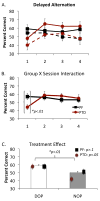Memory for reward location is enhanced even though acetylcholine efflux within the amygdala is impaired in rats with damage to the diencephalon produced by thiamine deficiency
- PMID: 20854918
- PMCID: PMC2980865
- DOI: 10.1016/j.nlm.2010.09.008
Memory for reward location is enhanced even though acetylcholine efflux within the amygdala is impaired in rats with damage to the diencephalon produced by thiamine deficiency
Abstract
A rodent model of diencephalic amnesia produced by thiamine deficiency (pyrithiamine-induced thiamine deficiency [PTD]) was implemented to assess both changes in behavior and acetylcholine (ACh) efflux in the amygdala across four training sessions of a delayed alternation task. Two versions of the delayed alternation task were used. In one version, when a correct alternation was made a unique reward was paired with each spatial location ([left arm-chocolate milk] or [right arm-rat chow]). This paradigm is called the differential outcomes procedure (DOP). In the second version of the task, correct delayed alternation resulted in the same rewards but randomized across location (Nondifferential Outcomes Procedure [NOP]). The PTD rats were impaired on the first session of delayed alternation testing. However, both control and PTD rats using the DOP performed significantly better on delayed alternation than rats trained with the NOP.This effect was driven primarily by the PTD rats in the DOP condition outperforming all other groups on sessions 2-4. Although ACh efflux in the amygdala increased during delayed alternation testing in all groups, the NOP-trained rats had a greater rise in training-related ACh release in the post-training period. This suggests that increased amygdalar cholinergic activation is more critical for processing spatial information than episodic reward information. These data correspond with the idea that cholinergic activation of the amygdala promotes processing in other neural systems.
Copyright © 2010 Elsevier Inc. All rights reserved.
Figures



References
-
- Aggleton JP, Neave N, Nagle S, Sahgal A. A comparison of the effects of medial prefrontal, cingulate cortex, and cingulum bundle lesions on tests of spatial memory: evidence of a double dissociation between frontal and cingulum bundle contributions. Journal of Neuroscience. 1995;15:7270–7281. - PMC - PubMed
-
- Butterworth RF. Cerebral thiamine-dependent enzyme changes in experimental Wernicke’s Encephalopathy. Metabolic Brain Disease. 1986;1:165–175. - PubMed
MeSH terms
Substances
Grants and funding
LinkOut - more resources
Full Text Sources
Medical

